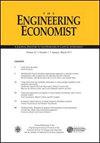编辑来信
IF 1.2
4区 经济学
Q4 BUSINESS
引用次数: 0
摘要
本期《工程经济学人》涵盖了工程经济研究的几个当代领域,包括投资组合优化、供应链管理和风险评估。我要感谢为同行评审过程做出贡献的评审员,以及区域编辑David Enke、Roy Kwon和Chin Hon Tan对本期的贡献。本期文章的开头是吴和王的一篇题为“基于随机优势的股票选择指数跟踪投资组合建模”的文章。作者利用股票过滤的随机优势方法建立了一个投资组合构建模型。他们的发现对那些负责在非预期效用函数下跟踪指数或满足投资者对不同对象的偏好的管理者具有启示意义。在蔡的《供应链财务绩效和战略地位的整体观》中,该研究引入了一种基于预测、聚类和分类三种流行的机器学习模型的分析方法,以提供目标公司财务绩效模式的整体观,从而研究其潜在的供应链战略。他们的方法是一致和稳健的,因为它考虑了降噪、异常值检测和特征选择功能。Le on、Mora和Perote的技术注释“将高阶矩纳入Gram-Charlier收益的风险度量的修正方差”介绍了一种新的投资组合选择风险度量,并通过使用泰勒展开将其性能与行为方差和修正方差这两个相关度量进行了比较。他们的工作考虑了最小方差和夏普比率标准,通过对11组股票采用随机投资组合优化技术。在上一篇文章中,Rosner、Yang、Rao和Scott合著了《具有信用担保和破产成本的资本约束供应链决策》。他们的文章提供了一个供应链融资模型,其中核心供应商为资本约束零售商提供银行贷款的信用担保。该模型考虑了产品的信用担保、破产成本和残值,并分析了包括银行在内的供应链参与者的决策行为。他们的结果表明,供应商可以调整信用保证系数来增加其利润,而降低零售商的利润,这可能会导致供应链的不稳定。《工程经济学人》杂志发表文章、案例研究、调查以及书籍和软件评论,代表涉及资本投资问题的原始研究、当前实践和教学。如有疑问或咨询,请联系我:hln@uark.edu.本文章由计算机程序翻译,如有差异,请以英文原文为准。
Letter from the editor
This issue of The Engineering Economist covers several contemporary areas of engineering economic research, including portfolio optimization, supply chain management, and risk assessment. I would like to thank the reviewers who contributed to the peer-review process as well as area editors David Enke, Roy Kwon, and Chin Hon Tan for their contributions to this issue. The issue begins with an article entitled “Modeling Index Tracking Portfolio Based on Stochastic Dominance for Stock Selection” by Wu and Wang. The authors develop a portfolio construction model using the stochastic dominance approach on stock filtering. Their findings have implications for managers who are responsible for either bringing greater outcomes from tracking an index under the non-expected utility function or satisfying the investor’s preference for the different object. In “On a Holistic View of Supply Chain Financial Performance and Strategic Position” by Tsai, the research introduces an analytical approach relies on three popular machine learning models, forecasting, clustering, and classification, to provide a holistic view of target companies’ financial performance patterns to study their underlying supply chain strategies. Their approach is consistent and robust as it considers noise reduction, outlier detection, and feature selection functions. The technical note “Modified Variance Incorporating High-Order Moments in Risk Measure with Gram-Charlier Returns” by Le on, Mora, and Perote introduces a new risk measure for portfolio choice and compares its performance with two related metrics, behavioral variance and modified variance, by using a Taylor’s expansion. Their work considering minimum variance and Sharpe ratio criteria by employing random portfolio optimization technique for eleven sets of stocks. In the last article, Rosner, Yang, Rao, and Scott coauthor “Decisions on CapitalConstrained Supply Chains with Credit Guarantees and Bankruptcy Costs.” Their article contributes a supply chain financing model where the core supplier provides credit guarantee for the capital-constrained retailer to bank loans. The model takes the credit guarantee, bankruptcy costs, and salvage value of products into account and analyzes the decision-making behaviors of supply chain participants, including the bank. Their results show that the supplier can adjust the credit guarantee coefficient to increase its profit and lower the profit of the retailer, which may cause instability in the supply chain. The Engineering Economist journal publishes articles, case studies, surveys, and book and software reviews that represent original research, current practice, and teaching involving problems of capital investment. For questions or inquiries, please contact me at hln@uark.edu.
求助全文
通过发布文献求助,成功后即可免费获取论文全文。
去求助
来源期刊

Engineering Economist
ENGINEERING, INDUSTRIAL-OPERATIONS RESEARCH & MANAGEMENT SCIENCE
CiteScore
2.00
自引率
0.00%
发文量
14
审稿时长
>12 weeks
期刊介绍:
The Engineering Economist is a refereed journal published jointly by the Engineering Economy Division of the American Society of Engineering Education (ASEE) and the Institute of Industrial and Systems Engineers (IISE). The journal publishes articles, case studies, surveys, and book and software reviews that represent original research, current practice, and teaching involving problems of capital investment.
The journal seeks submissions in a number of areas, including, but not limited to: capital investment analysis, financial risk management, cost estimation and accounting, cost of capital, design economics, economic decision analysis, engineering economy education, research and development, and the analysis of public policy when it is relevant to the economic investment decisions made by engineers and technology managers.
 求助内容:
求助内容: 应助结果提醒方式:
应助结果提醒方式:


